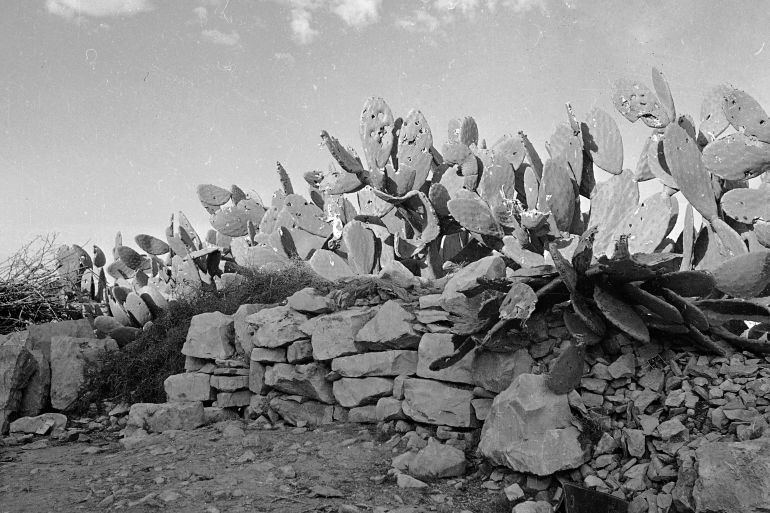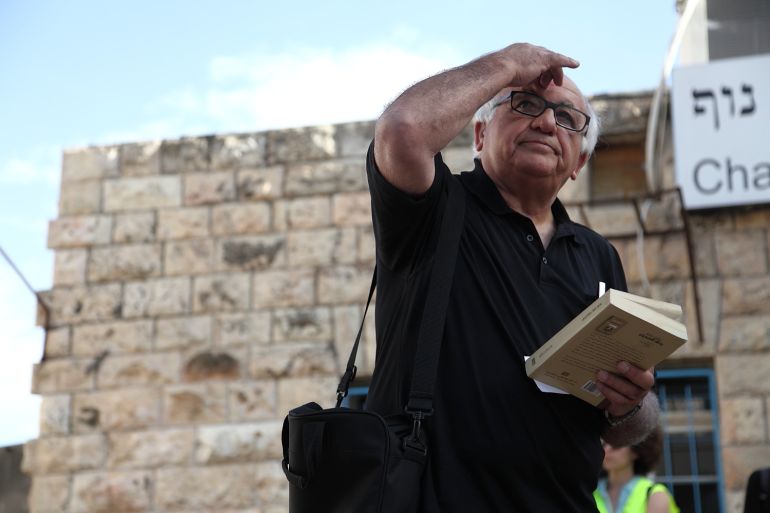al Jazeera:
The Deir Yassin massacre: Why it still matters 75 years later
The brutality of the Deir Yassin prompted thousands of Palestinians to flee, just weeks before Israel was created.
The brutality of the Deir Yassin prompted thousands of Palestinians to flee, just weeks before Israel was created.

Bullet-riddled cacti are seen in Deir Yassin, where more than 100 Palestinians, mostly women, children and the elderly, were massacred by Irgun-Stern raiders, April 1948 [AP Photo]
Published On 9 Apr 20239 Apr 2023
Seventy-five years ago, Zionist militias tore through Palestinian villages, massacring the villagers and expelling those who remained alive, to clear the way for the creation of the state of Israel.
An estimated 15,000 Palestinians were killed and some 750,000 fled their homes to live as refugees in other parts of Palestine or neighbouring countries, an event known by Palestinians as the Nakba – “the catastrophe”.
KEEP READING
Seventy-five years ago, Zionist militias tore through Palestinian villages, massacring the villagers and expelling those who remained alive, to clear the way for the creation of the state of Israel.
An estimated 15,000 Palestinians were killed and some 750,000 fled their homes to live as refugees in other parts of Palestine or neighbouring countries, an event known by Palestinians as the Nakba – “the catastrophe”.
KEEP READING
This year, the United Nations will host its first-ever high-level event to commemorate this forced displacement that resulted in the establishment of the state of Israel on May 15, 1948.
But Palestinians have never ceased to commemorate the loss of each village that was once part of their homeland.
Among them was Deir Yassin, a village perched on a hill west of Jerusalem, that has come to be emblematic of the suffering the Jewish nation-state inflicted on the Palestinians.
What is the Deir Yassin massacre?
On April 9, 1948, just weeks before the creation of the State of Israel, members of the Irgun and Stern Gang Zionist militias attacked the village of Deir Yassin, killing at least 107 Palestinians.
Many of the people slaughtered – from those who were tied to trees and burned to death to those lined up against a wall and shot by submachine guns – were women, children and the elderly.
As news of the atrocities spread, thousands fled their villages in fear. Eventually, some 700,000 Palestinians would flee or be forcibly displaced at the outset of Israel’s creation, making the massacre a decisive moment in Palestinian history.
What happened in Deir Yassin?
It was a Friday afternoon when the militia struck Deir Yassin, where about 700 Palestinians lived. Most were quarry workers and stone cutters.
According to the Israeli narrative, Operation Nachshon aimed to break through the blockaded road to Jerusalem and the fighters encountered stiff resistance from the villagers that forced them to advance slowly from house to house.
But Palestinians and some Israeli historians say the villagers had signed a non-aggression agreement with the Haganah, the pre-Israeli-state Zionist army. They were nevertheless murdered in cold blood and buried in mass graves.
According to a 1948 report filed by the British delegation to the United Nations, the killing of “some 250 Arabs, men, women and children, took place in circumstances of great savagery”.
“Women and children were stripped, lined up, photographed, and then slaughtered by automatic firing and survivors have told of even more incredible bestialities,” the report said. “Those who were taken prisoners were treated with degrading brutality.”
Israeli historian Benny Morris said the militias “ransacked unscrupulously, stole money and jewels from the survivors and burned the bodies. Even dismemberment and rape occurred.”
The number of dead is disputed but ranges from 100 to 250. A representative of the Red Cross who entered Deir Yassin on April 11 reported seeing the bodies of some 150 people heaped haphazardly in a cave, while around 50 were amassed in a separate location.

The entrance to a cemetery for Deir Yassin’s notable citizens before the April 1948 massacre. The occupation forces put up a sign in Hebrew and English that reads ‘Holy Place. No Entrance’ [AP Photo]
Prominent Jewish intellectual Martin Buber wrote at the time that such events had been “infamous”.
“In Deir Yassin hundreds of innocent men, women and children were massacred,” he said. “Let the village remain uninhabited for the time being, and let its desolation be a terrible and tragic symbol of war, and a warning to our people that no practical military needs may ever justify such acts of murder.”
Prominent Jewish intellectual Martin Buber wrote at the time that such events had been “infamous”.
“In Deir Yassin hundreds of innocent men, women and children were massacred,” he said. “Let the village remain uninhabited for the time being, and let its desolation be a terrible and tragic symbol of war, and a warning to our people that no practical military needs may ever justify such acts of murder.”
Why does it matter to this day?
Morris noted that “Deir Yassin had a profound demographic and political effect: It was followed by mass flight of Arabs from their locales.”
News of the massacre spread panic among the Palestinians, prompting hundreds of thousands to flee.
Four nearby villages were next: Qalunya, Saris, Beit Surik and Biddu.
Deir Yassin was no mistake, according to Israeli historian Ilan Pappé.
“Depopulating Palestine was not a consequential war event, but a carefully planned strategy, otherwise known as Plan Dalet, which was authorised by [Israeli leader David] Ben-Gurion in March 1948,” Pappé wrote. “Operation Nachshon was, in fact, the first step in the plan.”
The massacre unleashed a cycle of violence and counterviolence that has been the pattern since. Jewish forces have regarded any Palestinian village as an enemy military base, which has paved way for the blurred distinction between massacring civilians and killing combatants, according to the historian.

In April 2015, internally displaced Palestinians and refugees in occupied East Jerusalem toured Deir Yassin with Israeli activists to commemorate the massacre. Palestinian author Salmun Natur read from his book, Memory Conversed With Me and Disappeared [Rich Wiles/Al Jazeera]
What does it say about Israel’s vision today?
Deir Yassin has become a powerful symbol of Palestinian dispossession, as well as a historical fact Israel must confront when retelling its national narrative.
According to Pappé, given that “terrorism” is a mode of behaviour that Israelis attribute solely to the Palestinian resistance movement, “it could not be part of an analysis or description of chapters in Israel’s past”.
“One way out of this conundrum was to accredit a particular political group, preferably an extremist one, with the same attributes of the enemy, thus exonerating mainstream national behavior,” he wrote.
Israeli historians and Israeli society have been able to admit to the massacre in Deir Yassin by attributing it to the right-wing group Irgun, but have covered up or denied other massacres – notably the one in Tantura in 1948 – carried out by the Haganah, the main Jewish militia from which the current-day Israeli military has evolved.
Despite this shift of blame, leading human rights organisations like Human Rights Watch (HRW) and Amnesty International have labelled Israel itself an apartheid state.
“We reached this determination based on our documentation of an overarching government policy to maintain the domination by Jewish Israelis over Palestinians,” HRW said in 2021.
“As recognition grows that these crimes are being committed, the failure to recognize that reality requires burying your head deeper and deeper into the sand,” it added. “Today, apartheid is not a hypothetical or future scenario.”
Explore a database of destroyed Palestinian villages on PalestineRemix.com
Deir Yassin has become a powerful symbol of Palestinian dispossession, as well as a historical fact Israel must confront when retelling its national narrative.
According to Pappé, given that “terrorism” is a mode of behaviour that Israelis attribute solely to the Palestinian resistance movement, “it could not be part of an analysis or description of chapters in Israel’s past”.
“One way out of this conundrum was to accredit a particular political group, preferably an extremist one, with the same attributes of the enemy, thus exonerating mainstream national behavior,” he wrote.
Israeli historians and Israeli society have been able to admit to the massacre in Deir Yassin by attributing it to the right-wing group Irgun, but have covered up or denied other massacres – notably the one in Tantura in 1948 – carried out by the Haganah, the main Jewish militia from which the current-day Israeli military has evolved.
Despite this shift of blame, leading human rights organisations like Human Rights Watch (HRW) and Amnesty International have labelled Israel itself an apartheid state.
“We reached this determination based on our documentation of an overarching government policy to maintain the domination by Jewish Israelis over Palestinians,” HRW said in 2021.
“As recognition grows that these crimes are being committed, the failure to recognize that reality requires burying your head deeper and deeper into the sand,” it added. “Today, apartheid is not a hypothetical or future scenario.”
Explore a database of destroyed Palestinian villages on PalestineRemix.com
(Al Jazeera)
SOURCE: AL JAZEERA

As I have held repeatedly, there are and there were no innocent Good Guys in the Arab -Israeli conflict.
ReplyDeletePalestinian lovers will dredge up Deir Yassin , but pretend Dunno cases such as Kfar Etzion , the massacre of an entire Jewish Kibbutz by Palestinian terrorists at around the same period, slaughtering men,women and children.
https://en.wikipedia.org/wiki/Kfar_Etzion_massacre
Mfer, go ponder about CAUSALITY then u fart!
Delete